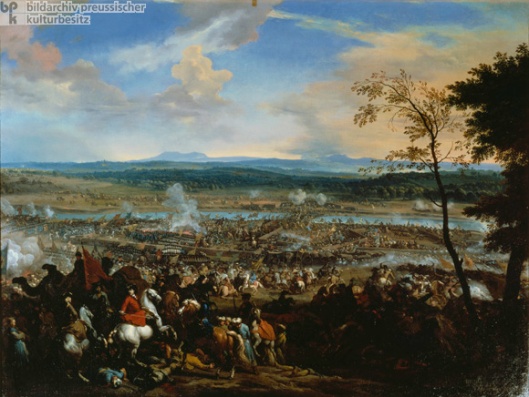Prince Eugene of Savoy and his General Staff at the Battle of Zenta
Battle of Zenta, September 11, 1697
PRINCIPAL COMBATANTS: Austria (with a Holy League consisting of the Holy Roman Empire, Venice, Poland, and, after 1686, Moscow) vs. Ottoman Empire
PRINCIPAL THEATER(S): Hungary and the Balkans
MAJOR ISSUES AND OBJECTIVES: Primarily, the possession of Hungary
OUTCOME: The Ottomans, badly defeated, were driven out of Hungary.
APPROXIMATE MAXIMUM NUMBER OF MEN UNDER ARMS: Holy League, 142,343; Ottoman Empire, 200,000
CASUALTIES: Holy League, 49,200 killed or wounded; Ottoman Empire, 156,000 killed or wounded
TREATIES: The Treaty of Karlowitz, January 26, 1699
On March 3, 1683, an Ottoman army of 200,000, allied with a Transylvanian force, invaded Hungary from Adrianople. Austria and Poland united to defend against the invaders, 150,000 of whom commenced a siege of Vienna on July 17, 1683. Vienna’s garrison consisted of about 11,000 regular troops and 6,000 volunteers. However, the defenders possessed superb artillery, which held off the Ottomans until September 12, 1683, when an Austro-Polish force of more than 60,000 arrived. By this point the Viennese garrison had lost 5,000 regulars and 1,700 volunteers, although the Ottomans had suffered losses amounting to some 40,000 killed or wounded, so that when the Austro-Polish force attacked from the heights of Kahlenberg, they faced a reduced Ottoman- Transylvanian force of about 138,000. Immediately seizing the initiative, the Austro-Polish army made a devastating attack that cost the Ottomans 15,000 killed and as many as 25,000 wounded. The Austro-Polish relief force lost 1,800 killed and 3,200 wounded.
As the Ottoman force retreated the Austro-Polish army pursued. The Ottoman column crossed the Danube on a boat bridge, which collapsed, adding another 7,000 fatalities to the Ottoman toll.
The victory at the Siege of Vienna brought an end to the Ottoman threat against Europe. However, the war continued, albeit with many lulls. In 1684 Charles of Lorraine (1604-75) attempted to take Buda, which the Ottomans had held for 145 years. Charles failed, and half of his 34,000-man army perished. A second siege resulted in victory, however, on September 2, 1686, although Austrian losses in this campaign amounted to some 20,000 killed or wounded.
On August 12, 1687, Charles defeated the Ottomans at the Battle of Harkany, inflicting some 20,000 casualties. This victory liberated Croatia from the Ottoman Empire.
In 1687 Sultan Mohammed IV (1648-87) was overthrown, and the new sultan, Süleyman II, renewed the struggle against the Austrians and their allies. Holy League forces were defeated at Zernyest, Transylvania, in August 1690, allowing the Ottomans to capture most of Serbia by October. Belgrade fell to the Turks on October 8. In response Louis of Baden (1655-1707) led Holy League forces in a counteroffensive and defeated a combined Ottoman- Transylvanian force at the Battle of Szalankemén on August 19, 1691, inflicting some 20,000 casualties on the 80,000-man army. With this Transylvania became a Hapsburg possession.
The war continued in desultory fashion until Sultan Mustafa II (r. 1695-1703) invaded Hungary with 50,000 troops in 1697. At the Battle of Zenta on September 11 Mustafa’s force was met by 31,343 Holy League troops under Eugene of Savoy (1663-1736). Eugene attacked when the Ottoman army was divided on either side of the River Theiss and was in the process of crossing a bridge. Eugene destroyed the bridge, then drove the invaders into the river, killing perhaps as many as 29,000 while suffering no more than 50 casualties himself, killed and wounded.
Zenta was one of the worst defeats suffered by the Ottoman Empire, and it prompted the Treaty of Karlowitz, concluded on January 26, 1699. Austria received most of Hungary and Transylvania, and the Hapsburgs thereby supplanted the Ottomans as the major power in southeastern Europe.
